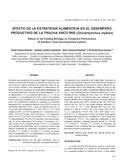Efecto de la estrategia alimenticia en el desempeño productivo de la trucha arco iris (Oncorhynchus mykiss)

Visualizar/
Data
2013-09-11Autor
Palabras Clave
Trucha arco iris, Tasa crecimiento, Tasa de crecimiento específico, Estrategia alimenticiaRainbow trout, Growth rate, Specific growth rate, Feeding strategy
Metadatos
Mostrar registro completoResumo
Se realizo un experimento en el estado Trujillo, Venezuela, para
evaluar el desempeño productivo de alevines de trucha arco iris
(Oncorhynchus mykiss) afectados por restricción social de peces
de mayor tamaño, a dos estrategias de alimentación. Durante
90 días (d), dos grupos de peces fueron alimentados con
un alimento balanceado comercial de la forma siguiente: T1, 5 d
de alimentación y 2 d de restricción (5A-2NA) y T2, 2 d de alimentación
y 1 d de restricción (2A-1NA). Cada 15 d se determinaron
el peso (g), la longitud (cm) y la biomasa íctica (kg) de los
peces. Se consideraron variables de respuesta, la conversión
alimenticia (CA), la ganancia diaria de peso (GDP), la tasa de
crecimiento específica (TCE), y tasa de sobrevivencia (S). La
CA no varió entre tratamientos (T1: 1,28 ± 0,05; T2: 1,37 ± 0,05)
aunque la GDP y la TCE fue superior en T1 comparado con T2
(GDP: 1,93 ± 0,07 versus 1,68 ± 0,07 para T1 y T2, respectivamente;
P<0,03; TCE: 2,28 ± 0,04 versus 2,14 ± 0,03 para T1 y
T2, respectivamente; P<0,02). Por otra parte, una mayor proporción
de peces sobrevivieron en el grupo T2 comparado al T1
(92,8 versus 94,2%, respectivamente; P<0,01). La evaluación
de la relación peso-talla indicó que, los peces de ambos tratamientos
mostraron un crecimiento alométrico minorante (T1:
P=0,046 L2,573; r=0,928; T2: P=0,028 L2,722; r=0,933). En conclusión,
la combinación de 5 d de alimentación y 2 d de ayuno produjo
el mejor desempeño productivo.
Colecciones
Información Adicional
| Otros Títulos | Effects of the feeding strategy on productive performance in rainbow trout (Oncorhynchus mykiss) |
| Correo Electrónico | ferromi@ula.ve |
| ISSN | 0798-2259 |
| Resumen en otro Idioma | An experiment was conducted in the Trujillo State, Venezuela, to evaluate the productive response of two different fed strategies in rainbow trout fingerlings (Oncorhynchus mykiss) affected by social restrictions due to size differences. During 90 days (d), two groups of fish were fed with a commercial balanced feed as follow: T1, five d feeding and two d fasting (5A-2NA) and T2, two d feeding and one d fasting (2A-1NA). Every 15 d the fish weight and length, and the total biomass (kg) were registered. As response variables were considered the feed conversion efficiency (CA), daily growth rate (GDP), specific growth rate (TCE) and survival rate (S). The CA was similar between treatments (T1: 1.28 ± 0.05; T2: 1.37 ± 0.05), although GDP and TCE were greater in T1 than in T2 (GDP: 1,93 ± 0.07 versus 1.68 ± 0.07 for T1 y T2, respectively; P<0.03; TCE: 2.28 ± 0.04 versus 2.14 ± 0.03 for T1 y T2, respectively; P<0,02). In another hand, greater proportion of fish survived in T2 compared to T1 (92.8 versus 94.2 % respectively; P<0.01). The weight-size relationship in both treatments indicated a minorant allometric growth (T1: P=0.046 L2.573; r=0.928; T2: P=0.028 L2.722; r=0.933). In conclusion, the combination of five d feeding with two d fasting (T1) determined the better productive performance. |
| Colación | 341 - 349 |
| Periodicidad | Bimestral |
| Institución | Universidad del Zulia (LUZ) Universidad de Los Andes (ULA) |
| Publicación Electrónica | Revista Científica |
| Sección | Revista Científica: Vida Silvestre |





